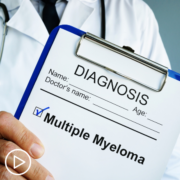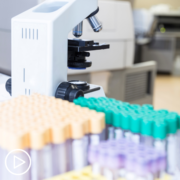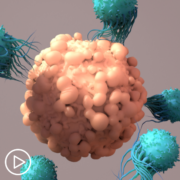Tag Archive for: hematology
Multiple Myeloma Clinical Trials: Which Patients Should Participate?
Multiple Myeloma Clinical Trials: Which Patients Should Participate? from Patient Empowerment Network on Vimeo.
When is the right time to consider a myeloma clinical trial? Dr. Mark Schroeder discusses when this may be an appropriate myeloma treatment option and shares patient resources for accessing and identifying clinical trials.
Dr. Mark Schroeder is a hematologist at Siteman Cancer Center of Washington University School of Medicine in St. Louis. Dr. Schroeder serves as Associate Professor in the Department of Medicine. Learn more about Dr. Schroeder.
See More from Engaging in Myeloma Treatment Decisions
Related Resources:

|

|
Transcript:
Katherine Banwell:
PEN community member, Mark, sent in this question prior to the program, “When is the right time for a clinical trial? When everything else is refractory?”
Dr. Mark Schroeder:
No, I think clinical trials should be – you should engage your oncologist to talk about clinical trials right from the beginning. We typically think about clinical studies – they could be interventional where we’re actually giving a treatment. Some clinical trials are observational where we’re trying to learn about disease course in response to traditional therapies. Either of those may have direct benefit to the patient, or maybe it doesn’t affect the patient, but it affects future patients with myeloma.
There are clinical studies like I mentioned that are moving therapies that are approved, but they’re approved after patients have been treated four or five times for their myeloma, and they’re now being moved earlier in the treatment. Some of those are at the initial treatment of myeloma in that induction phase. And so, we think that maybe by using some of these newer therapies or that immunotherapy class earlier on in the treatment of myeloma could result in deeper responses.
We don’t know if it’s going to result in cures or that long remission beyond five or 10 years, but that’s the hope. If we can move the therapies earlier and prevent the cancer from becoming resistant to multiple treatments, maybe we can lead to longer remissions and longer survival of cancer patients. So, engage with your oncologist from the beginning through all of your treatment lines about clinical trials, is what I would say.
Katherine Banwell:
Well, how can patients find out about clinical trials and what might be right for them? Where should they start?
Dr. Mark Schroeder:
I mean, starting with your physician and having that conversation is a good start, but there are resources for patients. The Multiple Myeloma Research Foundation MMRF has good resources. There is a – called Myeloma Crowd that also has resources for patients with myeloma and social support for patients with myeloma to try to find and match you with a clinical trial. And then if you’re really academic and interested in doing your own homework online, all clinical studies in the United States, even internationally, are registered on a website called clinicaltrials.gov. Clinicaltrials.gov is – it can be searched, so you can search for myeloma; you can search for a specific drug.
That will tell you, where are the studies being done, who are the study personnel, who should I contact to find out about the study? Unfortunately, not everybody can travel for treatment for their myeloma, and the best chance of potentially participating in a research study is to initially talk with your oncologist about it. There may be a larger center nearby that you can visit to consider clinical trials.
Clinical trials that are trying to use the new immunotherapies would be a great option, but they may not be offered in, say, a community oncology practice. You have to have the infrastructure to conduct those studies. And if you have the resources to be able to travel, then finding something on clinicaltrials.gov and – I’ve had patients do the legwork and talk with their local oncologist and get referred to a center that actually has a study that they’re interested in participating.
But a lot of times, studies are going to have you visit the center for all the screening tests and all the procedures for study.
Katherine Banwell:
Right, so you have to know that you have the time available as well as the resources.
Dr. Mark Schroeder:
Right, and the resources to do it. Yeah.
Katherine Banwell:
Yeah. Trevor had this question, Dr. Schroeder, “My myeloma is considered high-risk. What treatment options are available to me, and are there clinical trials specifically for high-risk disease?”
Dr. Mark Schroeder:
Yeah, great question. High-risk myeloma happens in about a quarter of patients, so one in four patients will have high-risk myeloma at the diagnosis. And it’s important because we know that when we say high-risk, that means that the myeloma is going to potentially come back sooner after treatments. It doesn’t mean that the treatment you’re going to be given is less effective, but it has a high propensity to come back sooner.
Those patients with high-risk myeloma still benefit from a lot of treatments that we have for myeloma, but there are clinical trials geared to try and increase treatment in patients with high-risk myeloma to try to change the fact that their cancer comes back sooner than somebody who doesn’t have the high-risk features by using a novel chemotherapies or novel drugs to try to improve responses. So, there are for sure clinical studies, either at – potentially at initial diagnosis or at the time of relapse that could be entertained for patients with high-risk myeloma. And I would encourage you to seek those out for sure.
Katherine Banwell:
Great. Thank you.
What Emerging Myeloma Treatments Are Showing Promise?
What Emerging Myeloma Treatments Are Showing Promise? from Patient Empowerment Network on Vimeo.
Myeloma specialist Dr. Mark Schroeder reviews the latest advances in myeloma treatment, including a discussion of CAR T-cell therapy and bispecific antibodies.
Dr. Mark Schroeder is a hematologist at Siteman Cancer Center of Washington University School of Medicine in St. Louis. Dr. Schroeder serves as Associate Professor in the Department of Medicine. Learn more about Dr. Schroeder.
See More from Engaging in Myeloma Treatment Decisions
Related Resources:

|

|

|
Transcript:
Katherine Banwell:
What about emerging therapies for myeloma? What approaches are showing promise?
Dr. Mark Schroeder:
So, I think the biggest news in myeloma, and across a lot of cancers now, are immunotherapies. We know in myeloma – now we have two CAR T-cells –
Now a CAR T-cell is engineering your own immune cell called a T cell to express a receptor on its surface that binds to the myeloma, and then those immune cells go and kill the myeloma. That’s a form of immunotherapy.
There’s two CAR-T cells for treating myeloma after the myeloma has come back four times, has needed four treatments. Those are very active in that line of therapy, and we can see response rates over 80 percent in patients who otherwise weren’t responding to other approved therapies for myeloma.
On the other hand, there are other immunotherapies that are used earlier in the treatment course of myeloma. One that is not incorporated more frequently for the initial treatment is a drug called daratumumab – it’s an antibody. It’s a protein that binds to the surface of myeloma and stimulates the immune system to react against the myeloma. And so, it’s not a traditional chemotherapy, but it’s using your own immune system to attack the cancer.
And then a third one that’s probably just as – it looks just as potentially effective as CAR-T cells are called bispecific antibodies. And that would use a protein similar to daratumumab which is an antibody, but it uses parts of antibodies to bind to – it could be two different proteins – one expressed on a T cell, the other one expressed on the myeloma cells. And when it binds, it brings those two cells together and causes your own immune system to attack the myeloma. Those are also very effective, and within the next month or two, there will be a bispecific antibody approved for treating patients with myeloma.
Katherine Banwell:
Oh, that’s great news. Any others?
Dr. Mark Schroeder:
Yeah, well – I mean, the other potential – there are other immune cells called natural killer cells that are also in clinical trials for development to attack myeloma, and potentially even engineering those natural killer cells to attack myeloma.
There are other antibodies; sometimes the antibodies of protein bind a specific target on the surface of the myeloma. I mentioned one – daratumumab – but there is a whole list of others that are in clinical development. The one other antibody – or two, couple of other antibodies that are approved for treating myeloma are isatuximab which also binds to CD38. And another one called elotuzumab which binds to a protein called CS1 or SLAMF7 on the surface of myeloma.
That’s more information than you probably wanted or needed, but those antibody therapies can be very effective in treating myeloma. There is another antibody therapy that has a payload of a toxin on the antibody, and it binds to BCMA or B-cell maturation antigen.
That’s the same antigen that the bispecific antibodies as well as the CAR-T cells are targeting on myeloma surface, and so that is potentially one that is approved by the FDA also to treat myeloma.
Katherine Banwell:
As we close out our conversation, Dr. Schroeder, I wanted to get your take on the future of myeloma. What makes you hopeful?
Dr. Mark Schroeder:
Well, I am hopeful – just within the last five years, there have been a number of new drugs approved for myeloma. They are approved for later lines of therapy, but they are being moved earlier in the treatment. And within the last 10-20 years, we’ve seen an improvement in the survival of patients with myeloma. As these new therapies are in development, as they’re being moved earlier in the treatment line, I’m very hopeful that survival and potentially cure for this cancer is possible. The only way that we’re going to get to that point is through clinical research and for patients to partner with their physicians and to consider clinical trials because that is the only way that new drugs get approved and are available to other patients with myeloma. So, I’m excited about what is approved; I’m excited about what’s coming through the pipeline to treat myeloma.
Understanding Relapse in Myeloma
Understanding Relapse in Myeloma from Patient Empowerment Network on Vimeo.
What are indicators that a myeloma patient has relapsed? Dr. Mark Schroeder explains how relapsed and refractory myeloma are monitored and treated.
Dr. Mark Schroeder is a hematologist at Siteman Cancer Center of Washington University School of Medicine in St. Louis. Dr. Schroeder serves as Associate Professor in the Department of Medicine. Learn more about Dr. Schroeder.
See More from Engaging in Myeloma Treatment Decisions
Related Resources:

|

|
Transcript:
Katherine Banwell:
What are the indicators that a patient’s disease may have relapsed?
Dr. Mark Schroeder:
Yeah, so we would typically be following a patient about every three months. Somebody that has gone through the initial induction, consolidation, maybe they’re on maintenance therapy, or maybe they’re on active therapy for after they have relapsed from a myeloma.
Each of those visits every three months, we are monitoring bloodwork, we’re monitoring the monoclonal protein that the myeloma produces.
Or if it doesn’t produce much of that protein, we’re monitoring other parameters, so urine testing or maybe even imaging like a PET scan. And we’re looking for consistent rises in that number, and we’re looking for, not necessarily a little rise in the protein, but incremental continuous rise – that suggests that the myeloma is starting to grow again, and it’s growing on the current treatment, and we need to switch gears and try a different treatment. There are some patients who – that protein, the myeloma or the myeloma cancer doesn’t die to treatments – that’s refractory. So, we try a treatment, and there’s just no response. We don’t see a drop in the protein in the blood, we still see a good burden of the myeloma in the bone marrow biopsy. And those patients, that’s also an indication to try a different treatment.
Katherine Banwell:
You mentioned that myeloma often returns, so how typical is it for a patient to relapse?
Dr. Mark Schroeder:
Yeah, I would say that’s the norm for patients with myeloma. There are reports in patients who undergo things like stem cell transplant, that maybe 10 percent of patients might be out 10 years without detection of their myeloma, but that’s not the norm. So, most patients who are diagnosed with myeloma will go through periods of treatment and hopefully periods of remission – the majority go into periods of remission to myeloma where it’s not very active, but the myeloma tends to come back.
Katherine Banwell:
I think you’ve already answered this, but I’m going to ask you in case you give different or more information. If a person is relapsed or refractory, how are they typically treated?
Dr. Mark Schroeder:
So, when they relapse, it depends on their prior treatment. So, if the myeloma is not responding to a drug, then it is, from the physician’s perspective that’s treating you, a good idea to change the type of chemotherapy drug that you’re on. Any time, whether it’s diagnosis or relapse, clinical trials are appropriate to engage with and potentially even use as primary treatment. All clinical studies in myeloma or for cancer in general are typically engineered around active treatments for the cancer. And so, those studies in myeloma when you’re having the cancer relapse, say, early in the course of your cancer, those studies typically are geared to use drugs that are approved by the FDA. Later in the lines of treatment, maybe you’ve had to progress after four lines of treatment, but trying to move them earlier, and they’re very active in the fourth line.
So, you could potentially have access to an active treatment moved earlier in the treatment through a clinical trial. There is also a long list of other approved myeloma therapies. There is a good handout, I think, through the NCCN for patients for myeloma that lists a lot of the approved myeloma therapies and kind of guides patients. It’s a good resource book that I would point any of the listeners to.
Understanding Myeloma Treatment Types
Understanding Myeloma Treatment Types from Patient Empowerment Network on Vimeo.
What are the types of treatment available for myeloma? Myeloma expert Dr. Mark Schroeder reviews the myeloma treatment classes, including proteasome inhibitors, immunomodulatory drugs (iMids), and immunotherapy. Dr. Schroeder also discusses factors to consider when choosing therapy for patients with myeloma.
Dr. Mark Schroeder is a hematologist at Siteman Cancer Center of Washington University School of Medicine in St. Louis. Dr. Schroeder serves as Associate Professor in the Department of Medicine. Learn more about Dr. Schroeder.
See More from Engaging in Myeloma Treatment Decisions
Related Resources:

|

|

|
Transcript:
Katherine Banwell:
There are a number of treatments for myeloma patients. Can you talk about the types that are available?
Dr. Mark Schroeder:
Yeah. So, the classes of – actually there is lots of drugs approved for treating myeloma but also recently approved.
And we classify them into big categories. One of the categories is called immunomodulatory drugs – those are drugs like lenalidomide (Revlimid) and pomalidomide (Pomalyst), or even thalidomide (Thalomid), which was one of the first immunomodulatory drugs. Those are oral drugs that work on a specific pathway in the myeloma that leads to the myeloma cell dying. Another class of drugs are called proteasome inhibitors. Those include drugs like bortezomib or carfilzomib. Those drugs are often given under the skin or in the vein, and we know that they work really effectively on their own, but also when we combine them with an immunomodulatory drug like Revlimid or pomalidomide, the effect is even better. Another class is steroids. Steroids are kind of one of the first drugs used to treat this cancer, and steroids are effective at treating myeloma cells.
Plasma cells are responsive to steroids. One of the first treatment regimens used to treat myeloma were traditional chemotherapies, and those are usually reserved for later on. You might think of traditional chemotherapy that causes hair loss, nausea, vomiting, low blood counts. Those, decades ago, were used to treat myeloma, but now we have effective oral, IV, or injection into the skin that don’t cause a lot of the traditional chemotherapy side effects but are very effective at treating the myeloma. And then another major class of drugs are considered immunotherapies. So, these are treatments that are engineered to either stimulate the immune system to go attack the myeloma, or maybe it’s even using part of your own immune system to engineer it to go attack the myeloma.
Examples of those are called bispecific antibodies which kind of binds to the myeloma but binds to an immune cell, brings them together, or a CAR T-cell which takes your own T cells genetically modifies them to attack the cancer.
Katherine Banwell:
And there is also a bone marrow transplant. Is that right?
Dr. Mark Schroeder:
That’s right, yeah. I neglected – so, bone marrow transplant has been around for a while in myeloma. And despite it being around for so long and really good therapies being approved for myeloma, it’s still a standard treatment for myeloma. And bone marrow transplant in myeloma uses a traditional chemotherapy called melphalan that is associated with the chemotherapy side effects we talked about. But the advantage of bone marrow transplant is that it prolongs the time before the myeloma comes back and needs other treatments, and that’s why we do it. It can be toxic, but it can prolong the time before a patient needs another line of therapy.
Katherine Banwell:
We know that everyone’s diagnosis is different. So, how do you determine a treatment plan for an individual patient?
Dr. Mark Schroeder:
So, it depends in terms of the patient – initially, I will evaluate patients and determine how fit they are. Is it a patient that I think is strong enough to undergo a stem cell transplant? Is that going to be a benefit to them? That’s not necessarily a factor of just age, but it’s also, are they doing well functionally, or do they have any other medical problems like heart disease or kidney problems? Those things play into my decision on a treatment initially with patients.
So, whether you’re fit or unfit will help to guide what your treatment is going to be in general. Fit patients are somebody that could undergo multiple treatments, go through a transplant, have minimal toxicity, and recover fully after more intensive treatments.
Whereas, unfit may need more assistance, and we tend to reduce the intensity of treatments. It doesn’t mean the treatments, if you’re unfit, are less effective – they can be very effective. But our goals for treatment change in that situation. And we’re looking for responses but also looking for quality of life. And then it changes also depending on the genetics of the myeloma. Our treatment for patients who have genetic changes that are high risk will change compared to those that have what are called standard risk genetic changes.
So, that is an important point to discuss with your oncologist if you have – Do I have standard risk or high-risk genetic changes in my cancer? And does that effect my treatment? And then also, treatment in somebody who is being treated a second time or third time or beyond for their myeloma depends on what treatments you had before and how effective they were.
And what were your toxicities or side effects from those treatments? So, all those factors play into a decision of treatment for an individual.
What Are the Phases of Myeloma Treatment?
What Are the Phases of Myeloma Treatment? from Patient Empowerment Network on Vimeo.
Myeloma specialist Dr. Mark Schroeder explains the phases of myeloma treatment, defining induction, consolidation, and maintenance therapy for patients with myeloma.
Dr. Mark Schroeder is a hematologist at Siteman Cancer Center of Washington University School of Medicine in St. Louis. Dr. Schroeder serves as Associate Professor in the Department of Medicine. Learn more about Dr. Schroeder.
See More from Engaging in Myeloma Treatment Decisions
Related Resources:

|

|

|
Transcript:
Katherine Banwell:
Let’s talk about the different phases of therapy for myeloma, and I’m going to ask you for some more definitions. What is induction therapy?
Dr. Mark Schroeder:
Induction therapy is the first treatment that we’re starting for myeloma. It’s oftentimes a combination of a number of chemotherapies that our goal is to get control of the cancer quickly, so reduce the burden of the cancer in a patient’s body.
Oftentimes, when patients present with myeloma, that’s when the burden of cancer is the highest. So, induction therapy is a combination often of three or four different drugs given over the course of about three to four months to treat the myeloma and get initial control.
Katherine Banwell:
What about consolidation therapy? What is that?
Dr. Mark Schroeder:
So, after you have had a response to induction therapy, your oncologist might talk about, “Well, let’s deepen that response.” That’s when we think about consolidation. So, it’s going to be poten – most of the time is a change of therapy from the three or four drugs that you were treated for in the myeloma. An example of consolidation would be going through a stem cell transplant or more chemotherapy after stem cell transplant. So, that’s a change in therapy, and it ends up deepening the response, killing more of the cancer.
Katherine Banwell:
And what about maintenance therapy?
Dr. Mark Schroeder:
So, after you have gone through induction, you have control of the myeloma, we’ve deepened that response with consolidation, we know that myeloma is a cancer that tends to come back. And we know from experience that continuing some of the drugs that we used in induction at low doses are effective to try and prevent it from progressing or coming back, and it extends that period of time – and that’s maintenance therapy. It’s using some of the drugs we used to initially treat myeloma at lower doses to continue to suppress low levels of the cancer.
Understanding MGUS, Smoldering and Multiple Myeloma
Understanding MGUS, Smoldering and Multiple Myeloma from Patient Empowerment Network on Vimeo.
What is the difference between smoldering myeloma and monoclonal gammopathy of undetermined significance (MGUS)? Dr. Mark Schroeder defines these diagnoses and discusses how asymptomatic myeloma is monitored.
Dr. Mark Schroeder is a hematologist at Siteman Cancer Center of Washington University School of Medicine in St. Louis. Dr. Schroeder serves as Associate Professor in the Department of Medicine. Learn more about Dr. Schroeder.
See More from Engaging in Myeloma Treatment Decisions
Related Resources:

|

|

|
Transcript:
Katherine Banwell:
As a patient, engaging in your care starts with understanding your diagnosis, so I’d like to go through some definitions. What is multiple myeloma?
Dr. Mark Schroeder:
Multiple myeloma is a blood cancer. It’s a cancer in particular of a blood cell called a plasma cell. Everybody has normal plasma cells in their body. It’s part of your immune system that responds to infections; they are also cells that respond to vaccinations.
And when a plasma cell becomes a cancer, it often forms a cancer called multiple myeloma. And that cancer results oftentimes in damage to bones, low blood counts or anemia, potentially kidney problems, or possibly seeing high levels of calcium.
Katherine Banwell:
What about smoldering myeloma? What is that?
Dr. Mark Schroeder:
So, smoldering myeloma is a stage that happens prior to the development of myeloma that is causing organ damage. I talked about the damage to bones, kidneys, blood cells – that is called the CRAB criteria. The C stands for calcium, the R renal, A anemia, and B bones. We define myeloma by having damage to one of those four essential systems.
Smoldering myeloma can happen when we actually see plasma cells that look like myeloma – that look like cancer cells, but they’re not causing the CRAB features of multiple myeloma. And there is a chance that sometimes that smoldering form of myeloma, it’s not causing any damage, but it can evolve and change into myeloma.
Katherine Banwell:
What is MGUS?
Dr. Mark Schroeder:
MGUS is a stage that happens prior to smoldering myeloma. We know that MGUS which stands for monoclonal gammopathy of undetermined significance – it’s a mouthful. That’s why we like to say MGUS.
Katherine Banwell:
Yes.
Dr. Mark Schroeder:
But it’s a protein that can be detected in your blood. Sometimes that protein does not mean you have a cancer. We can detect proteins like that in blood in patients who have, say, autoimmune diseases, and they’re at low levels. It’s just an immune response; it’s produced by those plasma cells that can be cancerous, but sometimes plasma cells grow because they’re stimulated – they’re overstimulated.
And so, that monoclonal protein of MGUS can be detected in the blood, but we don’t see an increase in the number of cells in the bones that are classic for myeloma. But we know that about 1 percent of patients who have MGUS, every year, 1 percent might progress on to develop multiply myeloma. So, it’s a risk factor; it’s on the spectrum of disease from MGUS to smoldering myeloma to myeloma.
Katherine Banwell:
Okay. And how is asymptomatic myeloma monitored?
Dr. Mark Schroeder:
So, asymptomatic patients, I would consider those are the patients who have smoldering myeloma, so they don’t have the high calcium, the renal issues, anemia, or bone problems. And typically, those patients are followed up about every three to six months, depending on where they fit in kind of that spectrum of MGUS to smoldering myeloma to myeloma.
Sometimes patients who have clinically identified myeloma and it presents very heterogeneous sometimes. They may not have a lot of organ involvement or organ damage, and maybe they’re frail, they’re elderly. And it may be appropriate also to observe patients who actually have some of the findings of myeloma, but the disease doesn’t seem to be as aggressive.
Expert Perspective: Why Myeloma Patients Should Weigh in on Their Care Decisions
Expert Perspective: Why Myeloma Patients Should Weigh in on Their Care Decisions from Patient Empowerment Network on Vimeo.
Myeloma specialist Dr. Abdullah Khan shares key advice encouraging patients to participate in care and treatment decisions and discusses the importance of communicating symptoms and side effects to your healthcare team.
Dr. Abdullah Khan is a hematologist specializing in multiple myeloma and plasma cell disorders at the Ohio State University Comprehensive Cancer Center – The James. Dr. Khan is also an assistant professor in the Division of Hematology at The Ohio State University. Learn more about Dr. Khan.
See More from Engaging in Myeloma Treatment Decisions
Related Resources:

|

|

|
Transcript:
Katherine:
Let’s turn to decision-making, Dr. Khan. What is the role of the myeloma patient when making care and treatment decisions?
Dr. Khan:
As a provider, my role is to inform the patient of the facts and the need for a decision. The purpose of the discussions is to determine the patient’s goals and preferences, because it’s essential the patient’s values of respected. The best outcomes occur when the medical facts align with the patient’s preferences. And this is a multi-disciplinary team approach.
Katherine:
Why is it so important for patients to share any symptoms and side effects they’re having with their healthcare team?
Dr. Khan:
I read something recently on an NIH website titled “What Do I Need To Tell the Doctor?” that I think answers this question well. And I’m quoting the article. “Talking about your health means sharing information about how you feel physically, emotionally, and mentally. Knowing how to describe your symptoms and bringing up other concerns will help you become a partner in your healthcare.”
I think I really like that end, “partner in your healthcare.” The patient’s symptoms and suggest disease or disorder in the body. If there are concerns, this may prompt a clinic visit or the patient may be advised to go to the closest ER or urgent care depending on the urgency of the situation. But in other cases, the healthcare team may help provide reassurance that the symptom can be continued to be monitored more resolution, or it can be evaluated in more detail if it persists or worsens.
Katherine:
What about side effects? Why is that important for patients to share any side effects they may be having?
Dr. Khan:
Side effects may be a result of the disease itself. It might be a marker of the side effects from the treatment. Or I’m focused on the multiple myeloma, but there’s every other organ system in the body that also needs help. So, the myeloma might be doing okay. The treatment might be doing okay. But, for example, we might have a lung toxicity from their pre-existing COPD or a heart toxicity from their pre-existing coronary artery disease. So, it’s very important to share all symptoms So, we can see how to properly assess it.
Katherine:
And better care for the patient.
Dr. Khan:
Right.
Expert Perspective: Advances in Treating Relapsed and Refractory Myeloma
Expert Perspective: Advances in Treating Relapsed and Refractory Myeloma from Patient Empowerment Network on Vimeo.
Dr. Abdullah Khan, of Ohio State University Comprehensive Cancer Center – The James, reviews currently available treatments as well as those in development for patients with relapsed or refractory myeloma.
Dr. Abdullah Khan is a hematologist specializing in multiple myeloma and plasma cell disorders at the Ohio State University Comprehensive Cancer Center – The James. Dr. Khan is also an assistant professor in the Division of Hematology at The Ohio State University. Learn more about Dr. Khan.
See More from Engaging in Myeloma Treatment Decisions
Related Resources:

|

|

|
Transcript:
Katherine:
Are there any recent advances in treatment for patients with relapsed or refractory disease?
Dr. Khan:
Currently and in the past 20 years or so, we’ve seen about 20 approvals for new drugs for patients with multiple myeloma. The way the approval process works it typically looks at the effectiveness of a drug in the relapsed refractory setting first. And after establishing the safety and efficacy, the therapies are moved earlier in the disease course.
The great example of this are the anti-CD38 monoclonal antibodies daratumumab and isatuximab. They were first approved in the relapsed refractory setting in combination with other antimyeloma treatments. And due to their impressive effectiveness and relative safety, they’re already being used in the frontline setting for patients with newly diagnosed multiple myeloma.
In the newly diagnosed setting, a commonly cited study is the phase two GRIFFIN trial. And that added daratumumab to the BRd, or bendamustine (Bendeka, Treanda), lenalidomide (Revlimid), dexamethasone backbone.
And Europe, they completed the phase three study of adding isatuximab, the other anti-CD38 monoclonal antibody to the BRd backbone. And what we’re finding what was very effective in the relapsed refractory setting was actually adding to the efficacy of newly diagnosed treatment regiments. As a side note, these trials – there are also trials looking at daratumumab and isatuximab in the smoldering myeloma phase, so moving it even earlier.
I think one of the most attractive new targets in myeloma is targeting this antigen called B-cell maturing antigen, and a number of therapies are being developed or are already developed for it. The first approved was belantamab mafodotin, and this is an antibody drug conjugate.
So, when the antibody binds to BCMA on the multiple myeloma cells, it releases its toxic payload into the myeloma cell. And so, it’s very effective towards myeloma, and no other good cells or fewer other good cells are affected by it. To provide some numbers, in patients with a median of seven prior lines of treatments, meaning their myeloma had relapsed that many times, the response rate was about 30 percent. And a fifth of those patients had VGPR, very good partial response, or better response.
There are also bispecific antibodies that target this myeloma marker, and we anticipate getting one approved soon in the U.S. called teclistamab. Teclistamab is an antibody that binds both CD3 on T cells of the immune system and B-cell maturating BCMA on the myeloma cells.
So, the way this antibody kills myeloma is by activating the T cells, the immune system, and directly killing the tumor. So, this was recently published in the New England Journal of Medicine. And in people who were treated with at least five prior lines of therapy, the response rate was about 63 percent, and the median progression-free survival, or the time until the myeloma progressed, was about 11 months.
We were very active in a clinical trial looking at the effectiveness of another antibody, a bispecific antibody, called Regeneron 5458. In a similar patient population, the response rates were 75 percent in the higher-dose level group, and right now it’s actually a bit too early to tell how long the progression free survival is or the duration of response.
There are also other bispecifics in development targeting other myeloma markers ssuch as talquetamab, that binds to a marker called GPRC5D, and cevostamab, which binds to a marker called FcRH5. The response rates as single agents in patients with relapsed refractory multiple myeloma are 66 percent and 45 percent respectively. These are all incredible numbers for a single drug in the relapsed refractory setting.
How Does Disease Staging Affect Myeloma Treatment Choices?
How Does Disease Staging Affect Myeloma Treatment Choices? from Patient Empowerment Network on Vimeo.
What are the stages of myeloma, and how does this affect care? Dr. Abdullah Khan, a myeloma specialist, reviews how myeloma is staged, which genetic markers may affect risk, and the impact of staging on treatment decisions.
Dr. Abdullah Khan is a hematologist specializing in multiple myeloma and plasma cell disorders at the Ohio State University Comprehensive Cancer Center – The James. Dr. Khan is also an assistant professor in the Division of Hematology at The Ohio State University. Learn more about Dr. Khan.
See More from Engaging in Myeloma Treatment Decisions
Related Resources:

|

|

|
Transcript:
Katherine:
How does staging affect treatment option?
Dr. Khan:
Staging is done by two methods. The older method is the international staging system, abbreviated as ISS. And then there’s the newer revised ISS, or RISS.
The patients are assigned stages one to three. To determine the ISS you need lab values for the beta-2 microglobulin and albumin. For the revised ISS, you add on the lab value for LDH, lactate dehydrogenase, and you also add in the chromosome risk profile. So, there are certain genetic changes that predict a more aggressive myeloma. And the ones added to the revised ISS staging system are translocation 4;14, translocation 14;16, and deletion 17p.
So, that’s the ISS stage and the revised ISS stage. There are also other factors patient providers look into when determining the risk profile for patients. So, that might include other genetic changes.
One that is gaining a bit more traction right now is something called gain 1q, or amplification 1q, so more than one copy of part a chromosome. Some patients might have myeloma that doesn’t start, and the bone marrow might be found outside of the bones. And that’s called extramedullary disease, and sometimes that’s kind of high-risk. And some people have so much bone marrow plasma cells that it actually spills into their bloodstream. So, they might have high circulating plasma cells. Anyway, this will give information on staging.
And in terms of how it affects treatment option, I’ll give maybe two examples. Let’s say in case one we have a 40-year-old patient high-risk multiple myeloma. The high risk portends a poorer prognosis, meaning the outcomes might not be as good as someone with a standard myeloma. So, in that case, I might try to do or use the most aggressive treatment option in order to maximize treatment responses because I know the overall outcome is poor.
I do all this while acknowledging maybe the chances of having side effects might be higher, but that might be an acceptable tradeoff.
In case two, I’ll flip to an 80-year-old with standard risk cytogenetics.
So, I predict their myeloma to behave standard. In this case, I might try to use a regimen with a more acceptable safety profile, because the predicted response to treatment is anyways very good. So, I don’t want to hurt them in the process of getting their myeloma in remission.
I’ll also say this. My practice pattern at The Ohio State University might be a little different than someone on the East Coast or West Coast, and that’s okay. We all have our experiences with the different treatment regimens, but we all have the same goal of being as aggressive as we can while being mindful of side effects.
How Is CAR T-Cell Therapy Changing Myeloma Care?
How Is CAR T-Cell Therapy Changing Myeloma Care? from Patient Empowerment Network on Vimeo.
Dr. Abdullah Khan discusses how CAR T-cell therapy works to treat myeloma, the currently approved CAR T-cell therapies, and the outcomes related to progression free survival (PFS) for patients with heavily pre-treated myeloma.
Dr. Abdullah Khan is a hematologist specializing in multiple myeloma and plasma cell disorders at the Ohio State University Comprehensive Cancer Center – The James. Dr. Khan is also an assistant professor in the Division of Hematology at The Ohio State University. Learn more about Dr. Khan.
See More from Innovative Myeloma Therapies
Related Resources:

|

How Is CAR T-Cell Therapy Changing the Myeloma Treatment Landscape? |

|
Transcript:
Katherine:
Let’s talk about CAR T-cell therapy. How is CAR T-cell therapy changing the field?
Dr. Khan:
Myeloma was a little late to the CAR-T game, but we’re very happy it’s here. The two products approved in myeloma are idecabtagene vicleucel, ide-cel for short, and ciltacabtagene autoleucel, or cilta-cel for short.
So, the way CAR Ts work, they are customized T cells for each individual patient. You collect the T cell from the patient with myeloma. You reengineer them in the laboratory to produce proteins on their surface called chimeric antigen receptor. That’s CAR portion of the CAR T therapy. And these CARs recognize and bind specific proteins on the surface of multiple myeloma.
So, these genetically modified T cells are then expanded or multiplied to make millions of cells. They’re sent back to the hospital where they were collected, where the patient is. And they’re infused back into the patient. The hope is that these modified cells, these CAR T cells, will continue to multiply in the patient. And with guidance from that engineered receptor, they will recognize and kill multiple myeloma very effectively.
So, I can provide some numbers to the outcomes of the two approved CAR T cells – CAR T products in multiple myeloma. The first approved was ide-cel in patients with a median of six prior lines of therapy, a single dose of CAR T was able to produce an objective response rate – that’s how many people responded to the treatment – of 73 percent, and the median, the middle person, progressed after 8.8 months of getting this treatment. The other product, cilta-cel, was also studied in patients with a median of six prior lines of therapy, and the objective response rate was an astounding 98 percent.
Katherine:
Wow.
Dr. Khan:
And the median progression-free survival is actually not yet reached. So, these are remarkable results with heavily pre-treated myeloma. And the myeloma community’s very excited to actually bring these treatments to earlier lines of therapy such as a newly diagnosed patient with multiple myeloma.
Advances in Myeloma Molecular Testing
Advances in Myeloma Molecular Testing from Patient Empowerment Network on Vimeo.
What is molecular testing, and how does it impact myeloma care? Dr. Abdullah Khan from the Ohio State University Comprehensive Cancer Center – The James discusses the specific markers found in cytogenetic analysis that determine a patient’s risk and may impact treatment choices.
Dr. Abdullah Khan is a hematologist specializing in multiple myeloma and plasma cell disorders at the Ohio State University Comprehensive Cancer Center – The James. Dr. Khan is also an assistant professor in the Division of Hematology at The Ohio State University. Learn more about Dr. Khan.
Related Programs:

What Tests Are Essential Before Choosing a Myeloma Treatment Approach? |

|

|
Transcript:
Katherine:
Have there been advances in molecular testing for myeloma patients?
Dr. Khan:
Molecular testing is a broad term and can indicate checking genes, proteins, and other molecules. Even let’s say speaking outside of the world of myeloma, molecular testing can be used to determine in individuals if they have a high chance of developing cancers or other diseases.
It can be done to confirm so cancer diagnoses using the tissue biopsy specimens. It can also be used to help plan treatment, find out how well the treatment is working, provide prognosis information, and other information. In the world of myeloma, there are – in the world of myeloma, there are researchers looking at all of these molecular changes that can happen with disease.
Katherine:
So, how do the results of these tests affect treatment?
Dr. Khan:
There’s a particular cytogenetic change called translocation 11;14 that’s found in maybe a quarter of all patients with newly diagnosed myeloma, and it predicts a high likelihood of responding to a new drug called venetoclax.
In the clinical trial of venetoclax, when it was given to all patients with multiple myeloma, there was actually higher mortality in patients when given venetoclax in combination with bortezomib and dexamethasone. And this is despite a higher response rate by adding the venetoclax.
The thought process was maybe those patients were not doing well because of higher chances of serious infections. But when they took the data and they looked at that subgroup of patients with the translocation 11;14, there was no such concern in that subgroup. So, in this case of having translocation 11;14, it actually giving you a new treatment option based on the findings of the molecular testing.
We participate in a national clinical trial called MyDRUG, and that’s looking at other molecular changes to see if a more targeted treatment when added to the backbone of myeloma therapies translates to better outcomes.
Another recent development in molecular testing is diagnostic testing for minimal residual disease, and that’s from the bone marrow in patients with multiple myeloma.
The most commonly used test in clinical trials is the clonoSEQ test; it’s an FDA-cleared diagnostic test. The way it works it looks for specific DNA sequences on the receptors of the cancer cells. So, each cancer cell has like a genetic barcode.
Using the liquid part of the marrow, we can look for those cells that harbor that genetic barcode.
And the test is so sensitive, we can find one in a million cells in a patient’s bone marrow aspirate. So, it’s a very sensitive test, but it is not yet approved for making treatment decisions. One way we can use it though is for prognostic information. So, a patient attaining minimal residual disease-negative status or MRD-negativity, probably will do better than someone who has MRD-positive disease.
And there’s an emerging concept called sustained MRD negativity. So, let’s take an example of someone getting MRD testing at one year and two years after their stem cell transplant. The patient who is MRD-negative at both the one-year and two-year marks will likely do better than the one who is MRD-negative at one year but turns positive at the two-year mark.
So, these are some of the new developments in molecular testing in multiple myeloma.
What Tests Are Essential Before Choosing a Myeloma Treatment Approach?
What Tests Are Essential Before Choosing a Myeloma Treatment Approach? from Patient Empowerment Network on Vimeo.
Dr. Abdullah Khan, a myeloma specialist, discusses the types of tests that myeloma patients should undergo before choosing therapy, at diagnosis, and if they relapse.
Dr. Abdullah Khan is a hematologist specializing in multiple myeloma and plasma cell disorders at the Ohio State University Comprehensive Cancer Center – The James. Dr. Khan is also an assistant professor in the Division of Hematology at The Ohio State University. Learn more about Dr. Khan.
Related Programs:

|

|

|
Transcript:
Katherine:
What testing should take place before choosing a myeloma treatment?
Dr. Khan:
I thought I could answer this question in an indirect way first.
Katherine:
Okay.
Dr. Khan:
I just wanted to let the audience know that anyone, including those that are not in the medical field, can create an account with the nccn.org. That’s the National Comprehensive Cancer Network’s website.
And from there they can download the myeloma guidelines, which are available to all myeloma providers as well. And in the guidelines, there are sections for workup, treatment, how to follow patients with myeloma, and many other things.
So, going back to the question, the first patient encounter will likely include a thorough history and physical exam. Initial lab work includes blood counts, the serum chemistries so we know about the liver and kidney function, multiple myeloma markers. And patients about get very familiar with monoclonal protein, the serum immunoglobulins, and the serum-free light chains.
These are used as the surrogates for responses when you’re undergoing treatment for the myeloma. We will also at the first visit probably also do a 24-hour urine collection, and that’s looking for the abnormal protein in the urine.
There’s imaging. In the past, we used to do x-rays head to toe. That’s sometimes called the myeloma survey or the skeletal survey. But the new recommendations are actually looking for something a bit more sensitive.
So, at our practice, what we do is a PET scan.
So, that includes functional information as well the images themselves. And some institutions may do a PET scan head to toe using low-dose radiation. The final test we will do in patients with newly diagnosed myeloma is a bone marrow biopsy and an aspirate.
So, the biopsy’s looking at the bone itself and the architecture. And the aspirate, you take the liquid part of the bone marrow, and you can ascertain a lot of information including the burden of myeloma when the patient’s newly diagnosed.
Katherine:
What do you mean by “burden”?
Dr. Khan:
You can quantify the number of cancerous plasma cells in the bone marrow. So, some of the information says you have a healthy amount of good bone marrow cells, 50 percent, 60 percent, for example, but of that 50 percent, 60 percent, maybe 80 percent is taken over by myeloma. So, you will get burden of myeloma information from there.
Katherine:
What additional testing should take place following a relapse?
Dr. Khan:
I’ll start that response by first talking about the types of relapses, and there are two broad categories. If we see the myeloma coming back as just the monoclonal protein going back up from its lowest, or maybe the serum-free light chain going up – and there are very specific criteria for what defiance a relapse. But if it’s just a number, we call it a biochemical relapse.
On the other side, there’s a clinical relapse. And at that point, there might be new end organ damage. We’ve heard of the acronym CRAB when we’re describing myeloma. That stands for hypercalcemia, renal or kidney insufficiency, anemia, and bone disease. So, these are end organ damage directly from the multiple myeloma.
So, typically, we’ll try to change the management at biochemical relapse, because a new organ injury may contribute to the patient’s frailty, or it might even limit the treatment options. The testing out of relapse is pretty similar to the first diagnosis. We’ll repeat the history and the physical example, the labs, imaging. And more often than not, I’ll also recommend a bone marrow biopsy to see is that myeloma changing genetically, and does it help me kind of determine new treatment options.
Myeloma Expert Debunks Common Clinical Trial Misconceptions
Myeloma Expert Debunks Common Clinical Trial Misconceptions from Patient Empowerment Network on Vimeo.
Dr. Abdullah Khan, a myeloma specialist, shares advice for individuals that may be hesitant to participate in a clinical trial, reviews the phases of trials, and explain the informed consent process.
Dr. Abdullah Khan is a hematologist specializing in multiple myeloma and plasma cell disorders at the Ohio State University Comprehensive Cancer Center – The James. Dr. Khan is also an assistant professor in the Division of Hematology at The Ohio State University. Learn more about Dr. Abdullah Khan.
See More from Myeloma Clinical Trials 201
Related Programs:

Understanding the Role of Clinical Trials As a Myeloma Treatment Option |

Considering Joining a Myeloma Clinical Trial? Questions to Ask Your Healthcare Team |

|
Transcript:
Katherine:
What would you say to someone who’s hesitant in participating in a trial?
Dr. Khan:
Well, the decision to participate is complex and personal, but the ultimate decision regarding trial participation rests with the patient. So, some of the reasons why patients might be hesitant, they might have distrust toward the medical community given the history of clinical trials in this country. If we take the example of the abuse of African American patients during the Tuskegee syphilis experiments, that’s just one example.
Katherine:
Yeah.
Dr. Khan:
Another reason patients might be hesitant is they don’t like the idea of being randomized to the treatment that they’re going to get.
So, they might end up getting a placebo. They might get another standard of care. And they might not get that new, fancy drug. So, giving up that level of control does require some compromise. Another reason is the uncertainty of the potential side effects of the chemotherapy drugs, especially if you’re participating in an early-phase clinical trial.
Furthermore, trials require very defined and frequent monitoring sometimes. So, some patients might not like the time commitment to a clinical trial. Another reason might be that there are concerns for cost. I can alleviate that concern by saying that typically there are mandates that the insurer cover the routine costs of clinical trials.
Katherine:
You mentioned some misconceptions. Are there any others that patients might have about participating in a trial?
Dr. Khan:
I guess the two most common things, the first one, and I think all providers have heard this, “I will be treated like a guinea pig.”
Katherine:
Yeah.
Dr. Khan:
For me, that is probably the furthest from the truth because of all the safeguards in place. Clinical trial participants are followed the most closely and probably get more medical attention than someone who is not on clinical trial. To participate in the clinical trial, the participant has to voluntarily – and that’s the keyword – sign an informed consent form. And finally, the participant can also leave the trial at any time for any reason.
Another common misconception is that clinical trials of dangerous because they use untested drugs. There might be some truth to that. There are many phases to clinical trials. And in some early-phase clinical trials it is true that participant may actually be the first to ever get the new therapy.
So, some of the outcomes are not known. But in late-phrase clinical trials, tens to thousands of patients may have already been treated with the study drug, so there a lot of preliminary safety data and also efficacy data.




